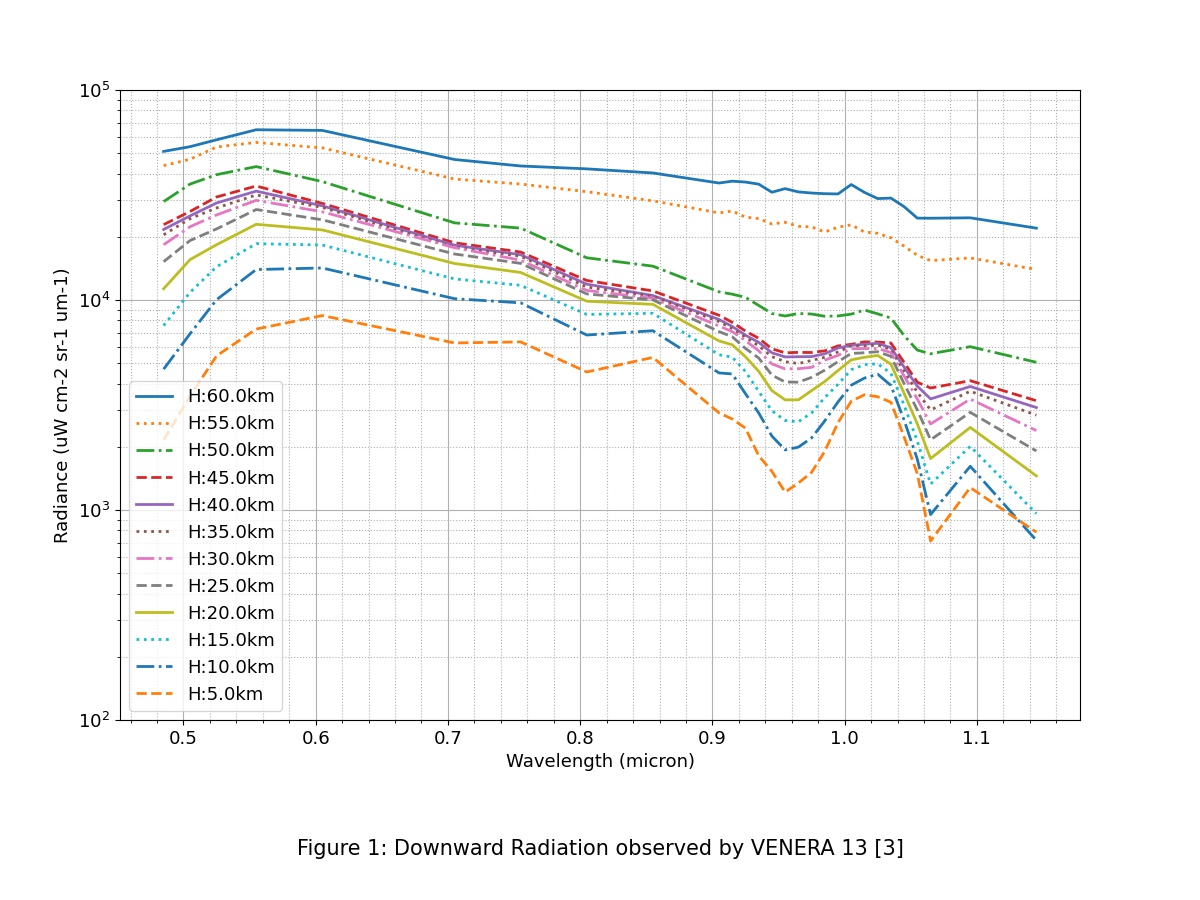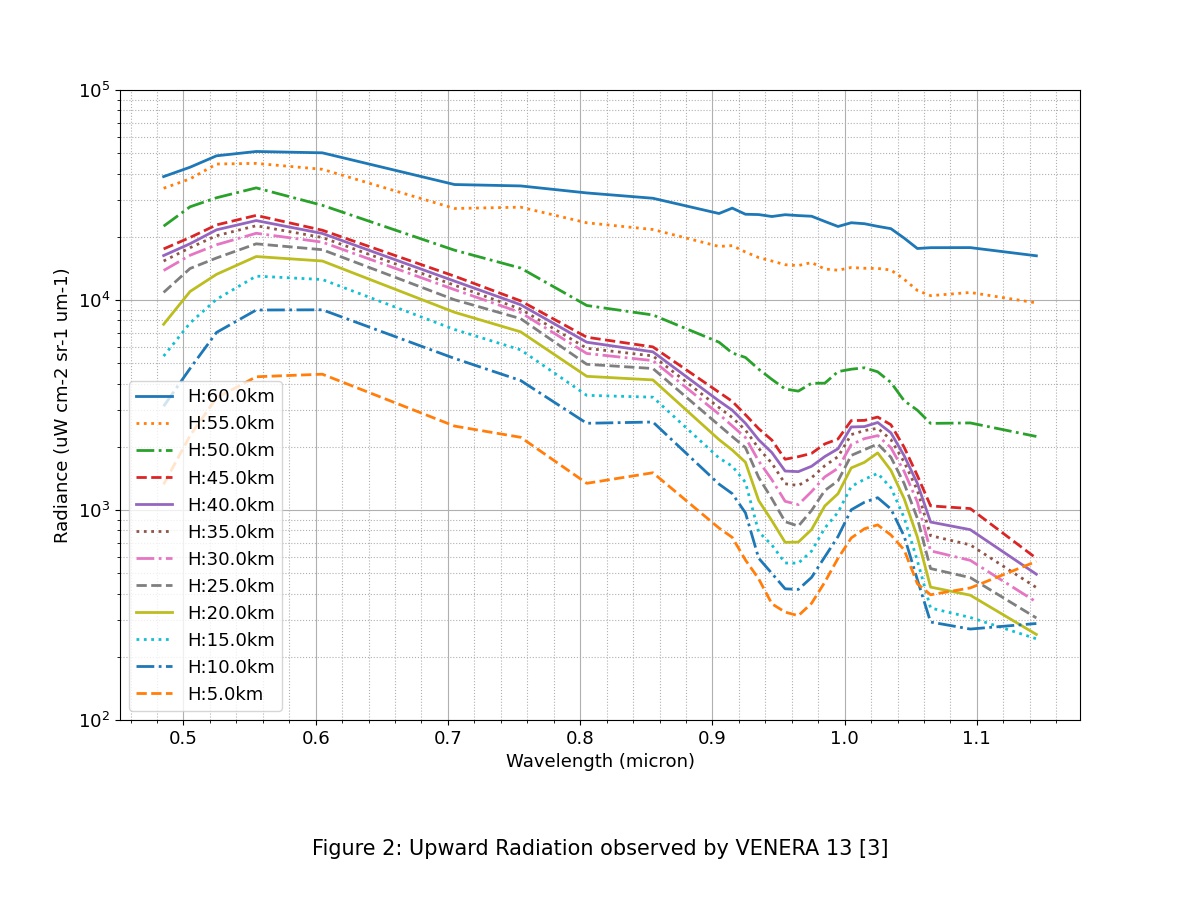Investigating the properties of a near-surface cloud layer from Venera 13 and 14 descent probe data
- 1University of Oxford, Atmospheric, Oceanic, and Planetary Physics, Department of Physics, Oxford, UK (shubham.kulkarni@physics.ox.ac.uk)
- 2ESA - European Space Research and Technology Centre, Noordwijk, Netherlands
The scanning spectrophotometers (IOAV-2) onboard Venera 13 and 14 probes recorded the internal radiation field from an altitude of 62 km down to the surface, covering a wavelength range of 0.48 to 1.14 μm. The radiation was recorded from six directions with a field of view of 20°. The original data from the magnetic tapes were lost. However, a secondary dataset was created using the graphic material published earlier that contains the radiation only from two directions (one close to the zenith and one close to the nadir). While analysing the secondary dataset, [1] reported a rapid change in radiances indicative of a near-surface cloud layer. The presence of such a cloud layer could be indicative of aeolian or condensing species; furthermore, it would affect the viability of surface imaging from a balloon and other missions. Motivated by upcoming Venus missions, we re-analyze this dataset to learn more about a possible near-surface cloud layer.
The secondary dataset is available in two formats: (a) High spectral resolution with low vertical resolution (e.g. 68 wavelengths x 11 altitudes for Venera 13) and (b) Low spectral resolution with high vertical resolution (e.g. 28 wavelengths x 52 altitudes for Venera 13). In this work, we use the second format to capture more information about the vertical structure of the atmosphere. We modify the NEMESIS radiative transfer and retrieval tool [2] for simultaneous fitting of upward and downward internal radiation at all altitudes. For example, the downward and upward spectra captured by Venera 13 [3] at twelve predefined altitudes, are shown in Figure 1 and Figure 2 respectively.
Before assessing the presence and properties of a near-surface cloud layer, it is necessary to first match the downwelling radiance from the main cloud deck in the atmosphere of Venus. Hence, NEMESIS is first used to retrieve particle properties in the main cloud deck. Using retrieved cloud abundances we set up the model atmosphere which is used to retrieve the properties of a near-surface cloud layer. Subsequently, the simulations are run for different particle sizes, abundances, and compositions to find the best match with the measured spectra. The results are used to comment on the existence of the near-surface cloud layer and on the properties of its constituent particles. Uncertainties associated with the particularities of the Venera probe measurements and their effects on assessing the presence of near-surface cloud layer and subsequent retrievals are briefly discussed in the end.


References:
[1] Grieger, B., Ignatiev, N. I., Hoekzema, N. M., and Keller, H. U., in European Space Agency, (Special Publication) ESA SP, number 544, 63–70 (ESA Publications Division, Noordwijk, Netherlands, 2004).
[2] Irwin, P. G., Teanby, N. A., de Kok, R., Fletcher, L. N., Howett, C. J., Tsang, C. C., Wilson, C. F., Calcutt, S. B., Nixon, C. A., and Parrish, P. D., Journal of Quantitative Spectroscopy and Radiative Transfer 109(6), 1136–1150 (2008).
[3] Moroz, V. I., Moshkin, B. E., Ekonomov, A. P., Golovin, Y. M., Gnedykh, V. I., and Grigorev, A. V., Soviet Astronomy Letters (1982).
How to cite: Kulkarni, S., Wilson, C., and Irwin, P.: Investigating the properties of a near-surface cloud layer from Venera 13 and 14 descent probe data, Europlanet Science Congress 2022, Granada, Spain, 18–23 Sep 2022, EPSC2022-1121, https://doi.org/10.5194/epsc2022-1121, 2022.

